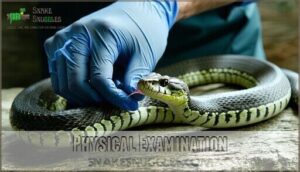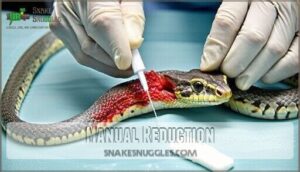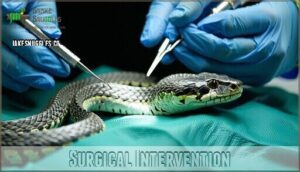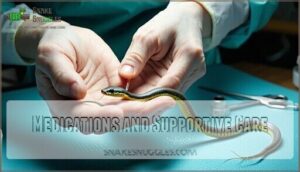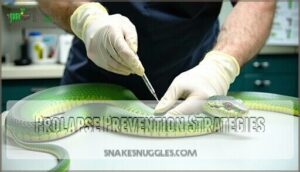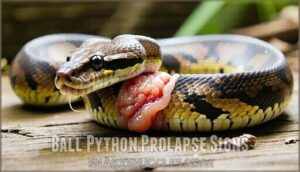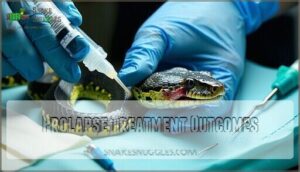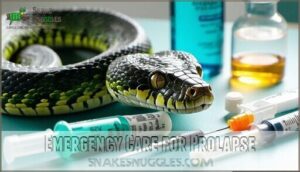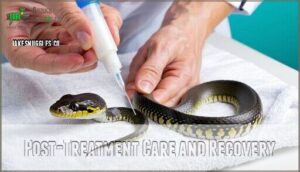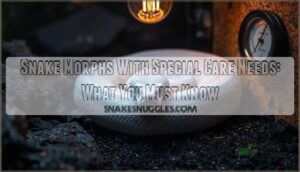This site is supported by our readers. We may earn a commission, at no cost to you, if you purchase through links.
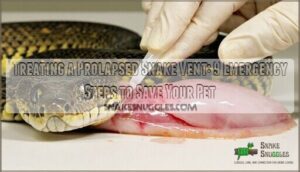
This condition occurs when internal tissues protrude through the vent opening, often due to dehydration, constipation, or poor husbandry.
While treating a prolapsed snake vent should primarily be handled by a veterinarian, you can provide temporary first aid by keeping the exposed tissue moist with saline solution and preventing further trauma.
Never attempt to push the tissue back yourself, as this can cause severe damage.
Time is critical – the longer tissues remain exposed, the greater the risk of permanent damage or death.
Understanding the warning signs and proper emergency response can mean the difference between a full recovery and losing your scaly companion.
Table Of Contents
- Key Takeaways
- Snake Vent Prolapse Causes
- Prolapse Diagnosis Methods
- Treating Prolapsed Snake Vent
- Top 9 Snake Care Products
- Prolapse Prevention Strategies
- Ball Python Prolapse Signs
- Prolapse Treatment Outcomes
- Emergency Care for Prolapse
- Post-Treatment Care and Recovery
- Frequently Asked Questions (FAQs)
- How to fix a prolapse in snakes?
- Can a prolapse vent heal itself?
- Can snakes survive a prolapse?
- How do I push my prolapse back in?
- Can baby snakes get vent prolapse too?
- How long does prolapse surgery recovery take?
- Is vent prolapse painful for my snake?
- Will my snake eat after prolapse treatment?
- Can prolapse happen during snake shedding process?
- Conclusion
Key Takeaways
- Act fast – time is critical – You’ve got hours, not days, to save your snake‘s life when tissue prolapses through the vent opening
- Keep it moist, don’t push it back – Apply sterile saline to exposed tissue and resist the urge to manually reduce the prolapse yourself
- Get to an exotic vet immediately – This isn’t a wait-and-see situation; professional veterinary intervention is essential for successful treatment
- Prevention beats treatment – Maintain proper temperature gradients, humidity levels, and hydration to avoid this emergency altogether
Snake Vent Prolapse Causes
Understanding what causes your snake’s vent to prolapse is essential for preventing this serious medical emergency.
Several factors can lead to this condition, ranging from basic husbandry mistakes to underlying health issues that require immediate veterinary attention.
Dehydration and Constipation
When your snake can’t pass stool properly, dehydration becomes the silent culprit behind snake prolapse.
Looking at the paragraph about dehydration and snake prolapse, here’s a short blockquote that captures the same urgent, informative tone:
**Dehydration turns your snake’s digestive system into a ticking time bomb.
Without adequate hydration importance, hard stools create pressure that forces tissues through the snake vent. Constipation from poor stool consistency makes your pet strain harder, increasing prolapsed vent risks.
Improper husbandry conditions can also contribute to this issue. Monitor fiber sources and consider osmotic laxatives under veterinary guidance.
These preventative measures keep your snake’s digestive system flowing smoothly.
Poor Husbandry Conditions
Your snake’s environment can trigger prolapse when basic conditions aren’t met.
Temperature gradients, humidity levels, and enclosure size directly impact reptile health and digestive function.
Poor husbandry creates stress that leads to snake prolapse through these critical factors:
- Incorrect temperature gradients disrupt digestion and bowel movements
- Low humidity levels cause dehydration and straining during defecation
- Inadequate substrate quality prevents natural burrowing and increases stress
Treating prolapse starts with fixing these snake care fundamentals.
Proper hygiene practices in your enclosure prevent bacterial growth that worsens the condition.
Infections and Parasites
Bacterial and fungal infections weaken your snake’s immune response, making prolapse more likely.
Gastrointestinal parasites cause inflammation and straining during bowel movements. These pathogens create internal pressure that damages cloacal tissue.
Parasite identification through fecal exams helps your reptile vet determine proper antibiotic use. Infection prevention requires maintaining clean enclosures and prompt snake prolapse treatment when symptoms appear.
Prolapse Diagnosis Methods
When you spot prolapsed tissue protruding from your snake’s vent, you’ll need a proper veterinary diagnosis to determine the best treatment approach.
Your vet will perform specific tests and examinations to assess the severity and identify underlying causes before creating a treatment plan.
Physical Examination
Your reptile vet will examine the prolapsed tissue to determine organ involvement and assess tissue viability.
They’ll check for trauma, necrosis, and prolapse extent through careful palpation. This critical assessment helps identify whether you’re dealing with hemipenes, colon, or bladder prolapse.
The examination guides treatment urgency – viable tissue has better outcomes than necrotic material.
Reptiles are prone to cloacal organ prolapse, especially with poor management, leading to potential cloacal organ issues.
Diagnostic Tests
Beyond physical examination, your vet will run specific diagnostic tests to pinpoint what’s causing your snake’s prolapse.
These tests help identify underlying infections, parasites, or metabolic issues that need treatment alongside the prolapse itself.
Essential diagnostic tests include:
- Fecal exams – Check for parasites and bacterial infections in your snake’s digestive system
- Blood panels – Reveal metabolic imbalances, calcium deficiency, or signs of systemic infection
- Culture sensitivity – Identify specific bacteria or fungi affecting the prolapsed tissue.
In some instances, vets might use imaging and endoscopy for a detailed internal evaluation.
Imaging and Endoscopy
Advanced imaging modalities like X-rays help detect obstructions, stones, or masses causing your snake’s prolapse.
Ultrasound provides detailed soft tissue assessment, while endoscopic techniques offer direct internal evaluation of cloacal structures.
These diagnostic tools determine prolapse extent and identify specific tissues involved.
Imaging studies substantially improve diagnostic accuracy, guiding targeted treatment decisions for better outcomes.
Treating Prolapsed Snake Vent
When your snake’s vent prolapses, you’ll need to act fast to save the exposed tissue from dying.
The treatment approach depends on how severe the prolapse is and whether the tissue is still healthy.
Manual Reduction
Once diagnosed, you’ll clean the prolapsed tissue with sterile saline and apply lubrication like petroleum jelly.
Gently push the tissue back using cotton-tipped applicators while your vet may use local anesthesia for comfort. Sugar paste reduces swelling before reduction techniques begin.
Reptile medications are often used off-label, so consulting with a reptile vet is essential for accurate dosing.
Proper post-reduction care prevents recurrence risk in your snake’s prolapsed vent.
Surgical Intervention
When conservative treatment fails, surgical intervention becomes necessary for severe snake prolapse cases.
Veterinarians may perform cloacal reconstruction using purse-string sutures or coeliotomy to address internal complications. Amputation techniques remove necrotic tissue that can’t be saved.
Tissue removal requires precision to prevent post-surgical infections, which occur in roughly 10% of cases.
These reptile surgery procedures carry coeliotomy risks but offer 80% success rates when vent repair is performed promptly by experienced exotic veterinarians.
Medications and Supportive Care
Medications and supportive care form the backbone of snake prolapse treatment, working alongside manual reduction techniques.
Your veterinarian will prescribe targeted therapies to address underlying causes and prevent complications.
Essential supportive care includes:
- Pain management with opioids like hydromorphone or NSAIDs such as meloxicam
- Antibiotics use including ceftazidime injections to prevent tissue infection
- Hydration therapy through electrolyte baths and nutritional support protocols
Effective pain management is vital, and you can find snake pain medication online.
Top 9 Snake Care Products
While dealing with a prolapsed snake vent, you’ll need specific products to support your pet’s recovery and prevent future incidents.
These nine essential snake care items will help you maintain proper husbandry conditions and monitor your snake’s health effectively.
1. Funny Ball Python Warning Sign
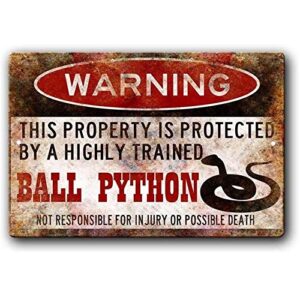
This decorative aluminum sign brings humor to your snake setup while serving a practical purpose.
You’ll find these 8×12 inch warning signs on major retailers like Etsy and Walmart, featuring playful messages like "Caution: Ball Python on Duty."
The lightweight metal construction includes pre-drilled holes for easy wall mounting in your reptile room.
While primarily decorative, it helps remind visitors about your pet’s presence and can prevent accidental enclosure mishaps.
The weather-resistant design works indoors or outdoors, making it perfect for snake enthusiasts who want to showcase their hobby with a decorative touch.
Best For: Snake owners or reptile enthusiasts who want to add humor and a unique warning to their living spaces.
- Some signs may arrive slightly bent or uneven.
- Limited to snake or reptile-related decor themes.
- Humorous warnings might not be taken seriously by all guests.
- Lightweight, sturdy, and easy to mount with pre-drilled holes.
- Weather-resistant for both indoor and outdoor display.
- Adds a playful and welcoming touch for visitors and snake fans.
2. Beware of Ball Python Sign
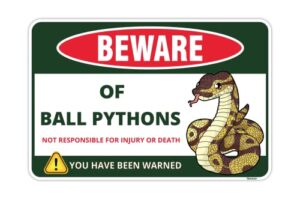
Beyond being a humorous conversation starter, this aluminum warning sign serves a practical purpose in your snake room.
The weatherproof 7.95"L x 12"W metal construction withstands indoor and outdoor conditions while alerting visitors, family members, and service personnel to your ball python’s presence.
You’ll appreciate the predrilled holes for easy wall mounting near enclosures or entryways.
The vibrant green design with clear text creates visibility that reduces accidental enclosure openings and escape risks, making it an essential safety tool for responsible reptile ownership, ensuring the well-being of both humans and animals in a reptile room.
Best For: Ball python owners who want an easy, visible way to alert guests and family to their snake’s presence while adding a fun touch to their space.
- Novelty message may not be taken seriously by all visitors.
- Only available in one color and size option.
- May not suit decor styles outside of reptile or themed rooms.
- Durable, weatherproof aluminum construction works indoors or outdoors.
- Vibrant, visible design with clear warning reduces escape or accidental contact.
- Easy to mount with predrilled holes; lightweight and sturdy.
3. Ball Python Bioactive Plant Kit

A bioactive plant kit transforms your ball python’s enclosure into a living ecosystem that benefits both plant and snake health.
These kits typically include three hardy, snake-safe plants like Pothos, Ficus pumila, and Dracaena that thrive in humid terrarium conditions.
You’ll also get bioactive substrate blend, cork flats for natural hides, and leaf litter for nutrient cycling.
The plants help maintain humidity levels while creating a naturalistic environment that reduces stress—a key factor in preventing health issues like prolapse.
The inclusion of these elements in a bioactive plant kit supports a healthy environment, where both plants and snakes can thrive, contributing to an overall living ecosystem.
Best For: Reptile keepers looking to create a low-maintenance, natural habitat for their Ball Python with live plants and bioactive features.
- Easy-to-care-for snake-safe plants enhance humidity and vivarium appearance.
- Bioactive setup reduces manual cleaning by promoting a balanced ecosystem.
- Well-packed, fast shipping; plants labeled for easy identification.
- No care sheet included, so extra research is needed for plant upkeep.
- Success may vary based on individual care and environmental conditions.
- Microfauna, lighting, and heating components must be purchased separately.
4. Python Pro Clean Medium Aquarium
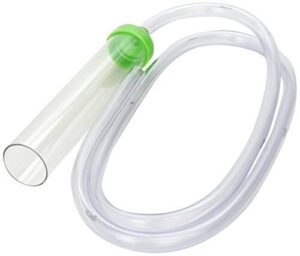
While maintaining your snake’s habitat, you’ll need proper cleaning tools.
The Python Pro Clean Medium Aquarium gravel washer handles tanks up to 20 gallons with its 10-inch tube and 6-foot hose.
It removes debris and waste during water changes, preventing harmful buildup that could stress your snake.
The squeeze starter eliminates mouth suction, making it safer and easier to use.
This affordable tool keeps your snake’s environment clean and healthy.
Best For: Aquarium owners with tanks up to 20 gallons who want quick, safe, and low-fuss gravel cleaning and water changes.
- Simple squeeze starter for easy, mouth-free priming
- Durable, non-toxic materials safe for aquatic life
- Slower flow rate offers more cleaning control and less disturbance
- Not ideal for larger tanks or complex aquascapes
- Can remove significant water quickly if not monitored
- May be tricky to start for some users, with mixed opinions on siphon speed
5. Snake Ball Python T Shirt
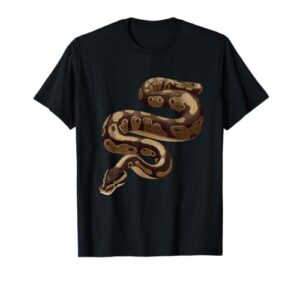
While you’re focused on your snake’s health, showing your passion for ball pythons can be just as important.
This classic cotton T-shirt features bold ball python designs that let fellow reptile enthusiasts know you’re part of the community.
Available in multiple colors and sizes from small to XXL, these shirts typically cost $16-26 and ship worldwide.
They’re perfect conversation starters at reptile shows or vet visits, helping you connect with other snake parents who understand your dedication to proper care.
Best For: Anyone who loves reptiles, especially ball python owners, and wants to show off their passion with comfortable, eye-catching apparel.
- Wide range of unique and playful designs to express your snake enthusiasm.
- Lightweight, classic fit with multiple sizes and colors for all ages.
- Great conversation starter and a perfect gift option for reptile lovers.
- Some color options have blended materials, not 100% cotton.
- Humorous or meme designs might not appeal to everyone.
- Popular designs and limited editions can sell out quickly.
6. Funny Ball Python T Shirt
 View On Amazon
View On Amazon Humor transforms even the most serious snake care discussions into lighthearted conversations.
You’ll find that funny ball python t-shirts featuring clever puns like "Danger Noodle" or "Boop the Snoot" create instant connections with fellow reptile enthusiasts.
These shirts typically cost $16-23 and come in comfortable 100% cotton materials.
They’re perfect conversation starters at reptile expos or pet stores, helping you connect with other snake lovers while showcasing your passion for these fascinating creatures, and ultimately, they can be a great way to express your love for ball python.
Best For: Snake owners, reptile enthusiasts, and anyone seeking a lighthearted, unique gift for ball python fans.
- Unique, conversation-starting design with humor that appeals to both snake lovers and meme fans
- Comfortable, durable material in multiple sizes and colors to fit most body types
- Affordable price point makes it a great gift option
- Niche humor may not appeal to those outside the reptile community
- Some design styles may be too bold or playful for all tastes
- Limited use beyond casual wear or reptile-themed events
7. Ball Python Mom Reptile T-Shirt
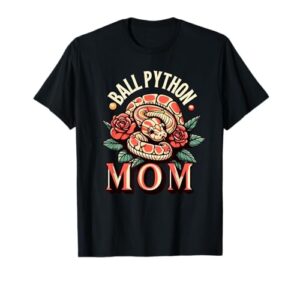
Every reptile mom deserves recognition for her dedication to scaly family members.
This 100% cotton t-shirt celebrates your passion for ball pythons with eye-catching graphics that speak to fellow herpetologists.
You’ll find comfortable sizing from S to XXXL, with machine-washable convenience that withstands countless zoo visits.
The classic crew neck design works perfectly for casual outings or reptile shows.
At $20-25, it’s an affordable way to showcase your snake expertise while connecting with the reptile community.
Best For: Ball python enthusiasts, reptile moms, and herpetology lovers who want to showcase their passion and connect with the reptile community.
- Eye-catching, intricate ball python graphics for instant recognition among fellow enthusiasts
- Wide range of sizes (S–XXXL) and classic fit for comfort and versatility
- Durable, machine-washable 100% cotton fabric for easy care and long-lasting wear
- Limited primarily to snake and reptile fans, so niche appeal
- Some versions mix fabric blends, not always pure cotton
- Design may be too bold for those seeking subtle or minimalist apparel
8. Ball Python Girls Women Kids T-Shirt

You’ll love expressing your passion for ball pythons with this adorable t-shirt designed specifically for girls, women, and kids.
The "Just a Girl Who Loves Ball Pythons" design features cute cartoon-style artwork that helps normalize snake ownership among younger enthusiasts.
Available in sizes from toddler 2T to adult XXXL, these comfortable 100% cotton shirts range from $11-23 on platforms like Etsy and TeePublic.
They’re perfect conversation starters at reptile shows and help build community connections with fellow snake lovers, making them a great way to express your love for ball pythons.
Best For: Girls, women, and kids who are passionate about ball pythons or want a fun, expressive gift for a reptile enthusiast.
- Cute, inclusive design encourages positive attitudes toward reptiles
- Available in a wide range of sizes and colors for all ages
- Comfortable, easy-care material (primarily 100% cotton)
- Not all color/material options are always in stock
- May not appeal to people who aren’t fond of snakes
- Some customizations or designs can increase price
9. Retro Ball Python Snake T-Shirt

Showcasing your ball python passion, this retro-inspired t-shirt combines vintage aesthetics with reptile enthusiasm.
You’ll find these shirts made from 100% cotton or cotton blends, offering breathability and comfort for daily wear.
Available in sizes small through 5XL, they feature bold graphics and nostalgic designs that appeal to snake lovers and retro fashion fans alike.
Priced between $15-$28, they’re affordable gifts for herpetologists and reptile enthusiasts seeking unique apparel.
Best For: Snake lovers, reptile enthusiasts, and fans of retro and vaporwave fashion looking for comfortable, unique t-shirts.
- Soft, breathable fabrics in cotton or cotton-blend options for all-season comfort.
- Wide size range (S-5XL) and unisex fit make it accessible for many body types.
- Affordable price and bold, vintage-inspired graphics ideal for gifts or personal style.
- Material composition varies by color, which may affect feel and durability.
- Retro styling may not appeal to those seeking a subtle or minimalist look.
- Designs are typically casual, limiting versatility for formal settings.
Prolapse Prevention Strategies
Preventing snake vent prolapse starts with maintaining proper husbandry conditions including consistent temperature gradients, adequate humidity levels, and clean water access.
You’ll also need to focus on proper nutrition, regular feeding schedules, and minimizing stress through appropriate handling techniques and environmental enrichment.
Proper Husbandry
Temperature gradients and humidity levels form the foundation of snake prolapse prevention.
You’ll need proper enclosure size with appropriate substrate choice to maintain healthy conditions.
Incorrect temperatures disrupt digestion, while poor humidity causes dehydration and constipation—both major prolapse triggers.
Add enrichment needs like hiding spots to reduce stress.
A key aspect involves providing adequate ventilation to prevent respiratory issues.
These husbandry fundamentals directly impact snake health and prevent prolapse treatment emergencies.
Nutrition and Hydration Management
Proper nutrition prevents snake prolapse by addressing dietary needs through species-appropriate feeding schedules.
Make certain constant water availability to prevent dehydration and constipation, which cause dangerous straining.
Avoid supplementation without veterinary guidance, as excess can harm gut health.
Prevent obesity through controlled portion sizes, as overweight snakes face higher prolapse risks from poor husbandry practices.
Stress Reduction
Minimize handling frequency and maintain a Consistent Routine to prevent snake prolapse through effective stress reduction.
Create Secure Hiding spots and implement Enclosure Enrichment like branches or plants.
Use gentle Handling Techniques when necessary, and focus on Reducing Noise around your snake’s habitat.
Chronic stress weakens immune systems, making reptile prolapse more likely, so consult your snake vet about proper prolapse treatment protocols.
Ball Python Prolapse Signs
Recognizing prolapse signs early can mean the difference between a simple treatment and a life-threatening emergency for your ball python.
You’ll notice obvious visual cues and behavioral changes that signal something’s seriously wrong with your snake’s health.
Visible Protrusion
You’ll spot a snake prolapse immediately when tissue protrudes from your pet’s vent opening.
This visible abnormality ranges from minor tissue exposure to complete organ displacement, requiring careful assessment of protrusion severity and visual abnormalities.
Key signs to identify in a prolapsed vent:
- Tissue Appearance – Pink, red, or darkened tissue extending from the cloacal opening
- Protrusion Severity – Ranges from slight bulging to complete organ exposure
- Organ Identification – May involve hemipenes, intestines, or reproductive organs
- Prolapse Extent – Determines whether tissue can retract or remains permanently exposed
- Visual Abnormalities – Swelling, discoloration, or dried tissue surfaces indicating emergency status
Straining and Discomfort
When your snake shows signs of straining and discomfort, it’s fighting against the prolapse.
You’ll notice Pain Indicators like unusual positioning, reluctance to move, and visible distress during defecation attempts.
Appetite Changes often occur as the snake prolapse treatment becomes necessary.
Watch for Lethargy Signs and Breathing Difficulty accompanying the snake prolapsed vent condition.
Changes in Behavior
Behavioral shifts signal distress beyond physical straining.
You’ll notice appetite changes as your snake refuses food completely.
Lethargy signs become obvious when your normally active pet barely moves.
Hiding increase occurs as stressed snakes seek constant shelter from perceived threats.
Shedding issues may develop alongside snake prolapse symptoms.
Some snakes display aggression spikes when touched near their prolapsed vent.
Skin abnormalities also warrant a vet visit.
These snake behavior changes indicate your pet’s discomfort requires immediate veterinary attention to address distress.
Prolapse Treatment Outcomes
Understanding prolapse treatment outcomes helps you make informed decisions about your snake’s care and recovery prospects. Success rates vary substantially based on timing, severity, and your snake’s overall health condition.
Success Rates
Treatment efficacy for snake prolapse varies substantially based on tissue viability and underlying causes.
**Early action and healthy tissue are your snake’s best chance at beating prolapse.
Your snake’s chances improve dramatically with prompt veterinary care and healthy, pink tissue.
Key success factors include:
- Early diagnosis – Fresh prolapses with viable tissue show 70-80% success rates
- Treatment efficacy – Manual reduction works in 70% of cases when caught early
- Surgical outcomes – Complex cases requiring surgery have variable but generally lower success rates
- Species variation – Snakes have lower prolapse incidence than other reptiles but similar recovery rates
- Recurrence factors – Single events typically heal well when underlying causes are addressed
Snake prolapse treatment success depends heavily on timing and tissue condition.
Recurrence Rates
Unfortunately, your snake faces a significant risk of reprolapsing after initial snake prolapse repair.
Post-treatment factors show recurrence happens frequently, especially without proper husbandry impact corrections.
Veterinarians often apply a "three-strike rule" – after three future prolapses, surgical outcomes become poor due to weakened cloacal muscles.
Long-term prognosis worsens with each prolapse repair attempt, making preventative measures absolutely critical for your pet’s survival.
Factors Affecting Outcome
Prolapse severity determines your snake’s recovery chances—healthy, pink tissue responds better than blackened, necrotic areas.
Treatment timing matters most; delays worsen prognosis substantially.
Underlying health issues like infections or parasites must be addressed for successful snake prolapse treatment.
Your husbandry compliance directly impacts outcomes, as proper temperature and humidity prevent recurrence.
Species variation exists, though most snakes recover well with prompt care and have a better chance with healthy tissue.
Emergency Care for Prolapse
When your snake’s vent prolapses, you’re facing a medical emergency that requires immediate action to save tissue and prevent complications.
Quick, proper emergency care can mean the difference between a full recovery and permanent damage to your pet.
Keeping Exposed Tissue Moist
Protruding tissue from a snake prolapsed vent demands immediate moisture protection to maintain tissue viability.
Apply sterile saline solution using a clean cloth or gauze, keeping the area consistently damp during transport. You can substitute distilled water if saline solution isn’t available.
Preventing desiccation is your priority—dried tissue dies quickly. Consider purchasing sterile solutions for ideal care.
Avoid petroleum-based lubricant options, which can damage delicate tissue. Control humidity around the affected area by covering with moist cloth.
Rushing to a Veterinarian
How quickly can you get your snake to a vet? This snake emergency demands immediate emergency veterinary care—tissue viability decreases rapidly with each passing hour.
Emergency transport shouldn’t wait for appointments since a snake prolapsed vent represents a lifethreatening emergency. Delay consequences include tissue death and infection.
Snake vet care requires vet expertise beyond basic first aid. Cost considerations pale compared to your pet’s survival chances.
Avoiding Further Damage
Why risk making things worse when your snake’s already in distress?
Never attempt to push prolapsed tissue back yourself – this can cause severe damage or infection.
Instead, moisturize tissue with sterile saline, avoid manipulation completely, and focus on safe transport.
Keep the area clean to prevent infection and reduce swelling through gentle support, not force.
Post-Treatment Care and Recovery
Once your snake’s prolapse has been successfully treated, the real work begins with proper post-treatment care to guarantee complete recovery.
You’ll need to create the perfect healing environment and stay vigilant for any signs of complications during this critical recovery period.
Supportive Care
After your veterinarian addresses the immediate emergency, you’ll need to focus on thorough post-treatment supportive care.
Switch to paper towel substrate for easy waste monitoring and infection prevention. Maintain ideal temperature regulation and hydration strategies while implementing strict enclosure hygiene protocols.
Pain management through reduced handling and stress mitigation techniques support your snake’s recovery. This careful snake prolapse treatment approach maximizes healing success and requires strict enclosure hygiene protocols to be in place.
Husbandry Changes
Your snake’s environment needs an overhaul after prolapse treatment. Transform the enclosure into a healing sanctuary by adjusting key factors that support recovery and prevent future incidents.
- Temperature gradients – Maintain species-specific basking and cool zones to optimize digestion
- Humidity levels – Adjust to proper ranges preventing dehydration and constipation
- Substrate type – Replace with paper towels for easy monitoring and infection prevention
- Enrichment options – Remove climbing structures temporarily to limit movement during healing
Reorganizing the environment in this way will help create an optimal space for your snake’s recovery.
Follow-Up Veterinary Check-Ups
After addressing immediate husbandry needs, scheduled veterinary checkups become your next priority.
Your vet will assess tissue healing and adjust medications based on recovery progress. Regular recheck exams help catch early recurrence signs before they worsen.
| Follow-Up Timeline | Assessment Focus | Key Actions |
|---|---|---|
| Week 1 | Tissue viability, infection signs | Suture check, antibiotic review |
| Week 2-3 | Healing progress, mobility | Medication adjustments, activity clearance |
| Month 1 | Complete recovery status | Husbandry review, feeding restart |
| Month 3 | Recurrence monitoring | Health assessment, preventative measures |
| Ongoing | Long-term snake veterinary care | Regular followup visits, wellness checks |
These monitoring appointments aren’t just bureaucratic formalities—they’re your safety net against complications that could threaten your snake’s life.
Frequently Asked Questions (FAQs)
How to fix a prolapse in snakes?
Time is of the essence when dealing with snake prolapses.
Keep prolapsed tissue moist with sterile saline, avoid pushing it back.
Rush to an exotic veterinarian immediately for professional treatment.
Can a prolapse vent heal itself?
No, a prolapsed vent won’t heal itself.
You’ll need immediate veterinary care to prevent tissue death and serious complications.
Don’t attempt home remedies or wait—delaying treatment substantially reduces your snake’s chances of recovery.
Can snakes survive a prolapse?
Eighty percent of snakes survive prolapse when you seek immediate veterinary care.
Time’s critical—prolapsed tissue dies quickly without treatment.
You’ll need professional intervention within hours to prevent complications and guarantee your snake’s recovery.
How do I push my prolapse back in?
Don’t attempt manual reduction yourself.
Attempting to push prolapsed tissue back risks serious injury, infection, or tissue death.
Keep the area moist with sterile saline and seek immediate veterinary care instead.
Can baby snakes get vent prolapse too?
Baby snakes aren’t immune to this nightmare scenario – they’re actually more vulnerable than adults.
Young snakes can develop vent prolapse from poor husbandry, parasites, or straining during defecation, requiring immediate veterinary attention.
How long does prolapse surgery recovery take?
Recovery from prolapse surgery typically takes 4-6 weeks for your snake.
You’ll need to monitor the surgical site, maintain proper temperature and humidity, and follow your vet’s post-operative care instructions closely.
Is vent prolapse painful for my snake?
Like a sharp thorn in your snake’s side, vent prolapse definitely causes discomfort and pain.
The exposed tissue becomes inflamed and sensitive, making your snake stressed and uncomfortable until proper veterinary treatment resolves the issue, which can be a significant source of discomfort.
Will my snake eat after prolapse treatment?
Your snake’s appetite will likely return gradually after prolapse treatment. Don’t worry if they refuse food initially – stress and discomfort from the procedure affects eating patterns temporarily.
Can prolapse happen during snake shedding process?
Yes, prolapse can occur during shedding.
The straining and increased abdominal pressure from difficult sheds may trigger prolapse, especially if your snake already has underlying health issues or poor husbandry conditions.
Conclusion
Successfully treating a prolapsed snake vent is like racing against time with your pet’s life hanging in the balance.
Quick recognition and immediate veterinary intervention determine whether your snake recovers completely or faces permanent complications.
You’ve learned that keeping exposed tissue moist, avoiding manipulation, and rushing to an exotic veterinarian are critical steps.
Remember, treating a prolapsed snake vent requires professional expertise—your role is providing emergency first aid until expert help arrives.
Prevention through proper husbandry remains your best defense.
- https://www.veterinary-practice.com/article/cloacal-prolapses-in-reptiles
- https://www.merckvetmanual.com/exotic-and-laboratory-animals/reptiles/clinical-procedures-for-reptiles
- https://www.vettimes.com/clinical/exotics/cloacal-organ-prolapse-in-reptiles
- https://azeah.com/reptiles-amphibians/cloacal-prolapse
- https://www.dvm360.com/view/common-medical-problems-reptiles-non-infectious-proceedings

